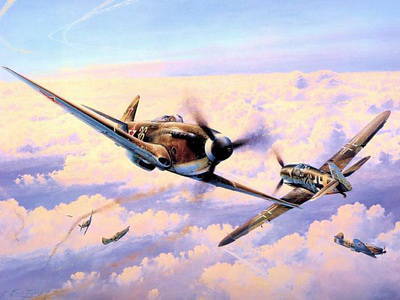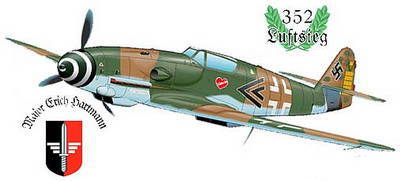Air Battle in Kuban
By mid-April 43, the Germans concentrated on the airfields of the Kuban and Crimea the main forces of their 4th air fleet - about 820 aircraft. In addition, they could attract another 200 bombers from airfields in southern Ukraine. A total of 4 air fleets totaled more than 1000 aircraft: 580 bombers, 250 fighters and 220 scouts. The best fighter squadrons of Germany were transferred here to support here: the 3rd Udet, the 51st Melders, the 54th Green Hearts, armed with the latest Me-109 and Fw-190 fighter models. Additionally, one fighter squadron of Slovakia, Croatia and Romania were used at this theater of operations.
The Soviet side also did not sit with folded arms, and already on April 18 began to deploy the 2 th bomber, 3 th fighter and 2 th mixed aircraft corps, as well as the 282 th fighter division, to the 900 aircraft , of which 370 fighters, 170 attack aircraft, 360 bombers of them 195 night. Of these, about 65% of the aircraft were new types: La-5, Yak-1, Yak-7B, British and American B-3 and B-20 bombers, as well as Spitfire and Air Cobra fighters. The concentration of such a number of aircraft in a fairly limited theater of operations predetermined a stubborn and intense struggle for air supremacy.
In total, three air battles took place in the sky of Kuban. The first of these began 17 on April 1943 of the year with an attempt to eliminate the bridgehead in the Myskhako area. In order to drop the 18 paratroopers of the army into the sea, the enemy attracted some 450 bomber and 200 fighter jets to cover. On the Soviet side, around 500 aircraft from them 100 bombers were used to counter the Germans. On this single day, German pilots made about 1000 sorties in the area. On April 20, the enemy again attempted to launch a powerful offensive, but this time the Soviet aviation managed to launch a preemptive strike with 60 bombers and 30 fighter jets half an hour before the offensive, and a few minutes later a new strike by the 100 group of planes, which disrupted the plans of the German command.

Then, from April 28 to May 10, an air battle unfolded in the skies over the Crimean stanitsa. The intensity of these battles may be indicated by the fact that during the 3 hours of the onset, German aircraft made more than 1500 sorties.
The last major air battles took place between 26 May and 7 June in the area of the Kiev and Moldavan villages at the breakthrough of the Blue Line of the Germans. For some time the Germans managed to seize superiority in the air, which greatly complicated the lives of the advancing troops. The countermeasure in response was the attack of Soviet aviation on German airfields. From 26 May to 7, June, the Red Army Air Force conducted 845 sorties on the airfields of the Nazis in Anapa, Kerch, Saki, Sarabuz and Taman. In total, during the battles in the sky of the Kuban, Soviet aircraft made about 35 thousands of sorties.
Losses
If we evaluate the losses of the parties, then the Soviet archives of the Red Army's air force destroyed the entire German 4 fleet, while the Germans for their part reported on the destruction of 1000 aircraft in air battles and 300 shot down by anti-aircraft fire, i.e. even more than they were in this sector of the front. So, it is possible to determine the losses of the parties only approximately, although the fact that the losses of both sides were enormous is beyond doubt.
Most likely, the losses of the Soviet side were higher, as the Germans paid more attention to the training of their pilots. There is no doubt that from the German side in the Kuban there were the best fighter pilots who flew in pairs since 1939 of the year. Even the young German pilots from the replenishment had a 200 flight hours, and on arrival they had to fly around 100 hours, in the front line, performing aerodrome protection tasks and studying the terrain. The Germans proceeded from the fact that the Russians had more pilots and airplanes, therefore they tried to keep the shots.
From the Soviet side, along with the aces such as: A. I. Pokryshkin, A. F. Klubov, G. G. Golubev, V. I. Fadeev, graduates of flight schools with a minimum amount of flight as well as pilots who arrived from the Far East participated or other remote districts with no combat experience. But even despite this, the approximate losses of the fighter pilots from Germany were 75 people, and taking into account allies about 135, which is half of the total number of 4 air fighters available at the beginning of the battle.
Faces of battle
Alexander Pokryshkin (6.03.1913 - 13.11.1985) - the second most effective pilot of the countries of the Anti-Hitler coalition, three times the hero of the Soviet Union. According to official data, he personally shot down the 59 aircraft, most likely, shot down an order of magnitude more, since the 1941 victory of the year, burned out along with the regiment's archives, as well as the enemy machines, which Pokryshkin wrote down on his followers, stimulating them in this way, dropped out of the standings.

In the sky of the Kuban Pokryshkin shot down according to official data 16 enemy aircraft. At this time, our illustrious ace flew on the American Air Cobra. Here are some of his outstanding performance fights. So April 12 over the village of Crimean Pokryshkin knocks down the X-NUMX of the Me-4 fighter, later that day he also shot down the 109 of the aircraft, bringing the number of vehicles brought down the day before 3, stories Soviet aviation was only one such case. A few days later, Pokryshkin knocks down the 3 Ju-87, and on April X, in the 28, the Aircobra fighters accelerate three nines of the Ju-8 dive bombers, personally destroying 87 from them.
The merits of Pokryshkin in the battle in the Kuban were highly appreciated, and on April 24 he received his first title of Hero of the Soviet Union, and in June he was promoted to the rank of Major. In addition to the Soviet awards in the same 1943, Pokryshkin was awarded the American Medal for Distinguished Service.
In most fights, Pokryshkin first tried to knock the leader down; he took this experience out of 1941-42 fights. Thus, often at the beginning of the battle it was possible to demoralize the enemy. Some historians attribute to him the creation of a new technique of air combat, which went down in history as the “Kuban bookcase”.
Erich hartman (19.04.1922 - 20.09.1993) is the most productive German pilot, is considered the most efficient fighter pilot in the history of aviation. Hartman won the 352 air victories 345 of which occur on Soviet aircraft, for his small stature and youthful appearance he received the nickname “Bubi” - baby. He was awarded the Knight's Cross with diamonds, only 27 people in the Reich had a similar award.
The battle over the Kuban Hartman was only a novice pilot, by the end of April 1943, he had 8 victories in his account, and he became the lead pair. The exact number of planes shot down by a pilot in the Kuban is not known, but on 7 July 1943, his account was already 21 victory. It was in Kuban that a young pilot, who at that time was a little bit over 20, began to hone his air combat skills, which were more than repaid in the future.

Throughout the war, Hartman flew exclusively on the Me-109 G fighter jets and adhered to a well-defined tactic - hitting from ambushes. According to Hartman, he never cared about the problems of air combat, he tried to avoid fights with fighters whenever possible. Hartman climbed as high as possible and, if possible, attacked the enemy from the side of the sun, in 90% of cases the enemy did not even understand what had happened. The pilot was guided by a well-defined formula of air combat and honed it throughout the war. His most important achievement Hartman believed that during the war he did not lose a single slave.
Hartman’s merits were also appreciated in the Soviet Union, where after the war he received 25 years of camps for damaging the Soviet economy during the war years. After serving in the Soviet camps for almost 10 years, in 1955, Hartman returned to his homeland.
Information